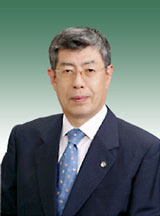|
Domestic Economy
During the period under review, the Japanese economy maintained a firm recovery tone. Despite lingering concerns about the economic impact of crude oil prices, exchange rates and overseas interest rate trends, corporate earnings and personal consumption improved in line with steady recovery in the global economy. However, in the last half of the fiscal year, there were continuing signs of weakness in some areas, and the recovery tempo slowed down.
Regarding domestic demand, consumer spending grew moderately, while housing investment, which had remained flat at the beginning of the reporting period, thereafter returned to a growth trend. Public works spending remained at a low ebb, but investment in plant and equipment showed growth momentum. Exports weakened somewhat during the reporting period after having maintained a moderate growth pace.
Industrial production showed growth momentum, supported by exports and investment in plant and equipment, and inventories were at a low level overall. Although corporate profits were blunted in the latter half of the period under review, for the term as a whole they showed great improvement on the back of an increased value of sales. The employment picture also improved, although conditions remained difficult.
Domestic commodity costs to companies rose, reflecting high product prices in domestic and overseas markets, due chiefly to rising crude oil prices. The consumer commodity price index, on the other hand, showed a modest decline year on year. The decline in land prices showed signs of bottoming out in metropolitan areas. |

|
Regional Economy
Despite signs of economic recovery in some parts of Wakayama Prefecture, the pace was slow and business confidence remained weaker than in the country as a whole. The Prefecture’s economic prospects remained rather cloudy.
Internal demand remained very weak, with anemic consumer spending. Although housing investment was at more or less the same level as in the previous year, public works investment fell. Capital investment likewise remained cautious, and subject to stagnation despite upward momentum.
Although industrial production showed sustained growth in some sectors, progress overall was barely perceptible.
The employment picture continued to record a moderate improvement, although figures remained low. The value of land continued to decline.
Conditions in the Financial Sector
As a result of continuing measures by the Bank of Japan to facilitate the smooth supply of funding, short-term interest rates remained at very low levels. In June, long-term rates rose to the 1.9% level, reflecting brighter assessments of Japan’s recovery prospects, but caution returned, and in the latter half, long-term interest rates moved to around the 1.3-1.5% level.
Stock market prices were firm at the beginning of the fiscal year. After plunging in response to expectations of financial tightening in the U.S. and China, the Nikkei average was boxed in a range around ¥11,000. After rising in response to stronger U.S. stock market prices from the beginning of December, the Nikkei average hit ¥11,668 at the end of the fiscal year.
The yen weakened briefly against the dollar to the ¥114 level in May, on expectations of a rise in U.S. interest rates, but in October the dollar was sold on concerns over America’s twin deficits (trade and budget), and the Japanese currency briefly climbed to the ¥101 level in January. The dollar was bought back afterwards and the yen reached the ¥107 level at the end of the fiscal year.
Tasks Ahead
The Japanese economy showed a generally firm recovery tone despite concerns in some areas. But in Wakayama and the south of Osaka prefectures, which constitutes our major business territory, recovery was very slow and business confidence remained weaker than in the country as a whole. As a result, economic prospects remained rather cloudy.
Against this background, the Bank is taking steps to boost profitability:
- Doing our best to respond to customers’ needs and contribute to the region
- Strengthening financial services for small and medium-sized enterprises (SMEs)
- Clearing up the non-performing loan (NPL) problem at an early stage, and
- Further reducing expenses
We have been undertaking particularly aggressive initiatives to strengthen relationship banking functions, an important policy for strengthening our own operational territories and revitalizing the regional economy. In particular, we are focusing on strengthening our abilities in three areas: management consulting and supporting functions for SMEs; comprehensive financing services for new SMEs; and enhancing the financial soundness and profitability of the Bank.
We believe it is important to grow our business with each of these initiatives serving as a major driver of our own profits, and to continue to pursue various policies aimed at transforming our organization into a more sophisticated and comprehensive financial services enterprise. Through ample disclosure of such initiatives by the Bank to our stakeholders, we will go on evolving into a financial provider even more deeply committed to our local community than hitherto.
On March 16, 2005, Kiyo Bank and Wakayama Bank agreed to establish a holding company on February 1, 2006. This move is part of our planned business integration under the holding company structure, on the assumption of a full merger during fiscal 2006. The alliance will enable us to realize our goals of assuming the structure of an integrated financial services supplier, contributing to the regional economy, strengthening our operating base, and providing diversified and sophisticated services. |